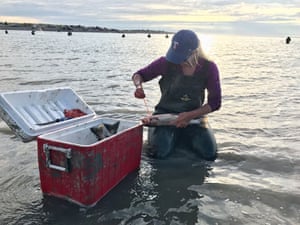Hundreds of fishermen stood chest deep in the brisk Alaskan river. Each held a five-foot net attached to a long metal pole. The only sounds were the quacks of seabirds and occasionally a new angler plodding into the water and asking, “have you caught anything yet?”
Down the beach, someone shouted, “They’re running!” As she and others began dragging their poles through the current they felt the familiar thumping of a sockeye salmon bouncing around in their nets.
In Alaska, out-of-staters often pay $200 to $500 for an afternoon of guided fishing. But, if you’ve lived in the state for a full calendar year, you gain a rare privilege, one that is proving all the more essential as the pandemic causes a spike in unemployment and hunger. For a few weeks in July and August, all resident Alaskans are permitted to catch multiple coolers-full of sockeye for free. All they need is a net.
Amid a festival atmosphere, Alaskans by their thousands wade with their dip nets into the mouth of the Kenai River, a few hours’ drive from Anchorage, known for its prolific quantity of sockeye, and into its twin, the Kasilof River, just down the road.
They’re allowed to take home 25 sockeyes for the head of household, plus 10 more for each additional family member. A family of four, for instance, may collect a total of 55. (The rest of the salmon season, where only rod and reel fishing is allowed, anglers are limited to just six salmon a day.)
“The fish are owned by all Alaskans equally,” said Rick Green, special assistant to the commissioner of the Alaska department of fish and game. “It’s a really cool, unique benefit that Alaskan residents get. It’s a way to use the resource owned by the people for the benefit of the people.”
While Alaska has a long history of subsistence living, this year, the pandemic’s impacts on the state’s large tourism and oil industries mean it feels more important than ever to stockpile the single largest shared natural resource in the state.
It’s too early to say how many salmon were harvested this season, though with more than 26,000 Alaskans households applying for dip-netting permits this year, it is probably around a half million.
“It’s hugely important for Alaskans,” said Green. “You’re talking $8 or more per pound of protein, and all these people are getting that just by sticking a net in the water. The freezer of meat they’ll have is worth thousands of dollars.”
Buying the same amount of salmon in a store would be prohibitively expensive for many of those taking to the Kenai.
If an angler is lucky, they might be able to catch several dozen fish in a single day. One fisherman, Jeff Todisco, caught 21 salmon on his first day dip-netting on the Kenai. “It’s insurance for the winter, making sure we can provide for our families,” said Todisco, who works in the airline industry and has a young daughter.
The practice is often referred to as “going to fish camp” because many people go for multiple days, spending the time between tides camping on the rocky beach.
No matter the year, the encampment is vast and eclectic, not unlike a music festival. On the dunes, just out of reach of high tide, colorful tents are pitched, lawn chairs surround fire pits, there are stacks of gear and coolers, and wet waders hang to dry. Because of the coronavirus, the city of Kenai has erected hand-washing and sanitizing stations.
It is strikingly egalitarian, because the only barrier to entry is obtaining a free license, which is easy enough, and owning or borrowing a dip net. Strolling among the tents, you can hear English, Russian, Arabic, Tagalog, Serbian, Samoan, Mandarin and myriad other languages being spoken. (This makes sense considering Anchorage, the state’s most populous city, is often ranked as one of the most diverse school districts in the nation)
The salmon swim upriver to spawn. While people prophesy about when it’s best to fish (on the incoming tide, just after high tide, during the slack tide), various factors determine when the fish come in the thickest, ranging from how far along the season is to how many commercial fishing boats are out. Often, it’s just luck.

One bluebird morning at the end of July, the fish started churning upriver in large numbers and the excitement was palpable. Children too small to hold a long net stood sentry on the shoreline, grasping small wooden mallets. When the salmon were ferried to shore, they ran up and offered to stun the animal with a quick blow to forehead. Several times, they join an excited hooting when fishers found multiple fish in their nets at once – the true sign of a bountiful tide.
Some were plunked into a cooler to be tended to after the run. Bigger groups set to work cleaning and filleting the fish immediately, running a knife along the belly from tail to head, pulling out the innards, and then pressing the blade along the bones to free the ruby red flesh. Overachievers went as far as smoking or vacuum-sealing theirs on the beach.
“Having salmon definitely makes a big difference for my family,” said Isaac Iaea, who has participated for the last eight years. He has six children and often sends smoked salmon to his parents in Hawaii. His eight-person household is allowed 95 fish.
“I’m very grateful for this,” Iaea said of his bounty. “It’s amazing that we’re able to do this. It means a lot.”